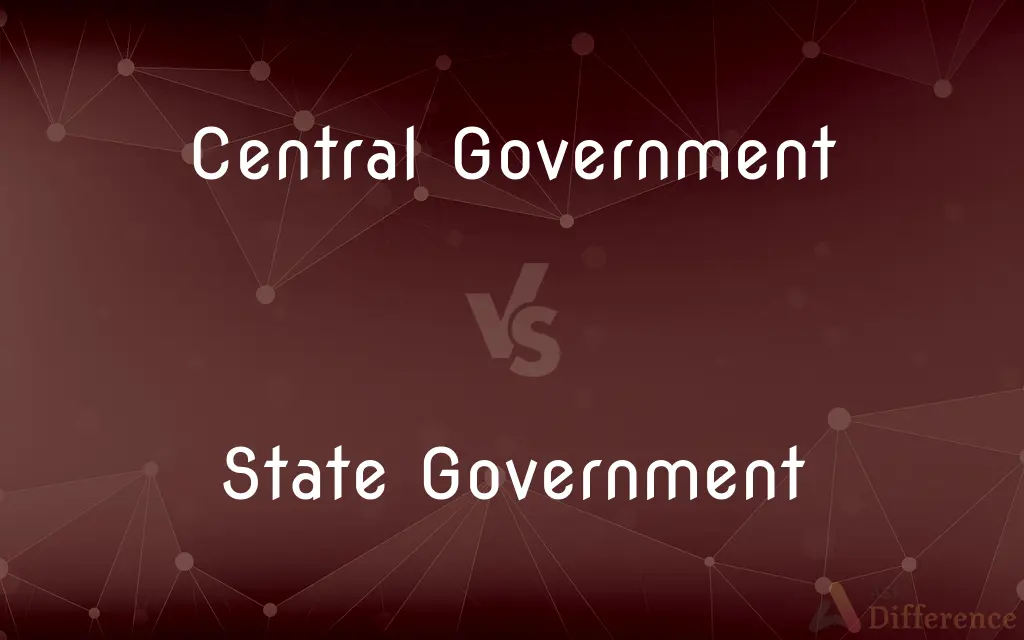Central Government vs. State Government — What's the Difference?
By Tayyaba Rehman & Fiza Rafique — Published on March 9, 2024
Central government operates at a national level, managing affairs affecting the entire country, while state government deals with matters within a specific state, focusing on local needs.

Difference Between Central Government and State Government
Table of Contents
ADVERTISEMENT
Key Differences
The central government, also known as the federal government in some countries, holds the highest level of authority, overseeing national policies, defense, foreign affairs, and federal laws. It is responsible for areas that affect the country as a whole, ensuring uniformity in essential regulations and standards. On the other hand, state governments operate within a smaller jurisdiction, focusing on local issues such as education, local law enforcement, and infrastructure. They tailor their policies and laws to meet the specific needs and preferences of their residents.
While the central government has the power to enact and enforce laws across the entire nation, state governments have the autonomy to establish their own laws and regulations in areas not exclusively reserved for the federal level. This division of powers allows for a balance between national unity and local autonomy, with each level of government having distinct roles and responsibilities. However, in cases of conflict between federal and state laws, federal laws generally prevail, highlighting the supremacy of the central government in the constitutional hierarchy.
Financially, both governments have their mechanisms for generating revenue. The central government typically collects taxes such as income and customs taxes, which fund national projects and federal services. State governments, meanwhile, may collect sales taxes, property taxes, and other fees to finance state-specific projects and services. This financial independence supports their operational autonomy, though states often receive federal funding for certain projects, especially those that align with national interests.
The structure of both governments often mirrors each other, with executive, legislative, and judicial branches at each level. This separation of powers ensures a system of checks and balances, preventing the concentration of power and promoting democratic governance. However, the specific powers and functions of each branch can vary significantly between the central and state governments, reflecting the different scopes of their responsibilities.
Choosing between central and state governance in policy-making involves considering the scale and impact of the issue at hand. Central government intervention is typically necessary for matters of national significance, such as defense and fiscal policy, while state governments are better positioned to address local concerns with greater flexibility and sensitivity to local conditions.
ADVERTISEMENT
Comparison Chart
Jurisdiction
National level
Specific state within the country
Responsibilities
Defense, foreign policy, federal law, national economy
Education, local law enforcement, infrastructure
Law Precedence
Federal laws generally have supremacy
State laws apply, but can be overridden by federal
Revenue Sources
Income tax, customs tax
Sales tax, property tax
Structure
Executive, Legislative, Judicial branches
Executive, Legislative, Judicial branches
Scope of Power
Broad, covering all states
Limited to within state boundaries
Autonomy
Limited by constitution but overarching
Significant within its jurisdiction
Focus
National interests and uniformity
Local needs and preferences
Conflict Resolution
Federal laws and courts generally prevail
State laws subject to federal review
Financial Independence
Generates own revenue, distributes funds to states
Generates own revenue, may receive federal funds
Compare with Definitions
Central Government
Governs at a national level, overseeing country-wide policies.
The central government passed a new national security law.
State Government
Operates within a specific state, addressing local issues.
The state government launched a new public health initiative.
Central Government
Responsible for national defense and foreign relations.
The central government negotiated a peace treaty with neighboring countries.
State Government
Has the autonomy to create laws in areas not federally preempted.
State governments set their own educational curricula.
Central Government
Works to ensure national unity and standardization.
The central government implemented a nationwide education reform.
State Government
Generates revenue through sales and property taxes.
State government initiatives are often funded by local taxes.
Central Government
Enacts federal laws that all states must follow.
New federal tax legislation was introduced by the central government.
State Government
Manages state infrastructure and local law enforcement.
The state government funded the construction of new roads and bridges.
Central Government
Collects income and customs taxes to fund national projects.
The central government funded the interstate highway system.
State Government
Tailors policies to the preferences of local residents.
The state government passed legislation reflecting the community's values.
Common Curiosities
Do state governments have any say in national policy?
State governments can influence national policy through their representatives in the national legislature and through intergovernmental negotiations.
What is the main difference between central and state government?
The main difference lies in their jurisdiction and scope of responsibilities: central government operates nationally, while state government focuses on local matters.
How are taxes distributed between central and state governments?
Central and state governments have distinct sources of revenue; however, the central government can distribute funds to states for specific projects.
Can state governments enact laws that contradict federal laws?
State governments can enact laws in areas not covered by federal law, but federal laws supersede state laws in case of conflict.
Can a state government interact with foreign governments?
Foreign policy is typically the domain of the central government, though states may engage in subnational diplomacy within federal guidelines.
What happens when a state law is challenged as being in conflict with federal law?
The judicial system, potentially culminating in the Supreme Court, can review and decide whether the state law is preempted by federal law.
Can the central government override state government decisions?
In matters of national importance and where the constitution grants authority, the central government can override state decisions, especially if they conflict with federal law.
How does the judicial branch fit into the central vs. state government dynamic?
Both levels have their judicial systems, with state courts handling state laws and federal courts handling federal laws, though the Supreme Court can resolve conflicts between state and federal law.
How do central and state governments cooperate?
Through fiscal transfers, shared responsibilities, and collaborative projects, central and state governments work together to address national and local issues.
How is law enforcement divided between central and state governments?
State governments typically manage local law enforcement, while the central government handles federal law enforcement and national security.
Which government is responsible for education policy?
Education policy is primarily the responsibility of state governments, though the central government can influence education through funding and national standards.
What role do citizens play in the governance at both levels?
Citizens participate in governance through voting in elections, engaging in public discourse, and serving on juries, influencing policies at both levels.
How does the balance of power between central and state governments affect democracy?
The balance of power ensures a check against the concentration of authority, promoting democratic governance by allowing local representation and national coherence.
Are there areas of shared responsibility between central and state governments?
Yes, areas like environmental protection and transportation can involve shared responsibilities, requiring cooperation between both levels.
What mechanisms exist for resolving disputes between central and state governments?
Judicial review and intergovernmental negotiations are key mechanisms for resolving disputes, ensuring a balance between national interests and state autonomy.
Share Your Discovery

Previous Comparison
Inner London vs. Outer London
Next Comparison
Ancient Greece vs. Ancient RomeAuthor Spotlight
Written by
Tayyaba RehmanTayyaba Rehman is a distinguished writer, currently serving as a primary contributor to askdifference.com. As a researcher in semantics and etymology, Tayyaba's passion for the complexity of languages and their distinctions has found a perfect home on the platform. Tayyaba delves into the intricacies of language, distinguishing between commonly confused words and phrases, thereby providing clarity for readers worldwide.
Co-written by
Fiza RafiqueFiza Rafique is a skilled content writer at AskDifference.com, where she meticulously refines and enhances written pieces. Drawing from her vast editorial expertise, Fiza ensures clarity, accuracy, and precision in every article. Passionate about language, she continually seeks to elevate the quality of content for readers worldwide.














































